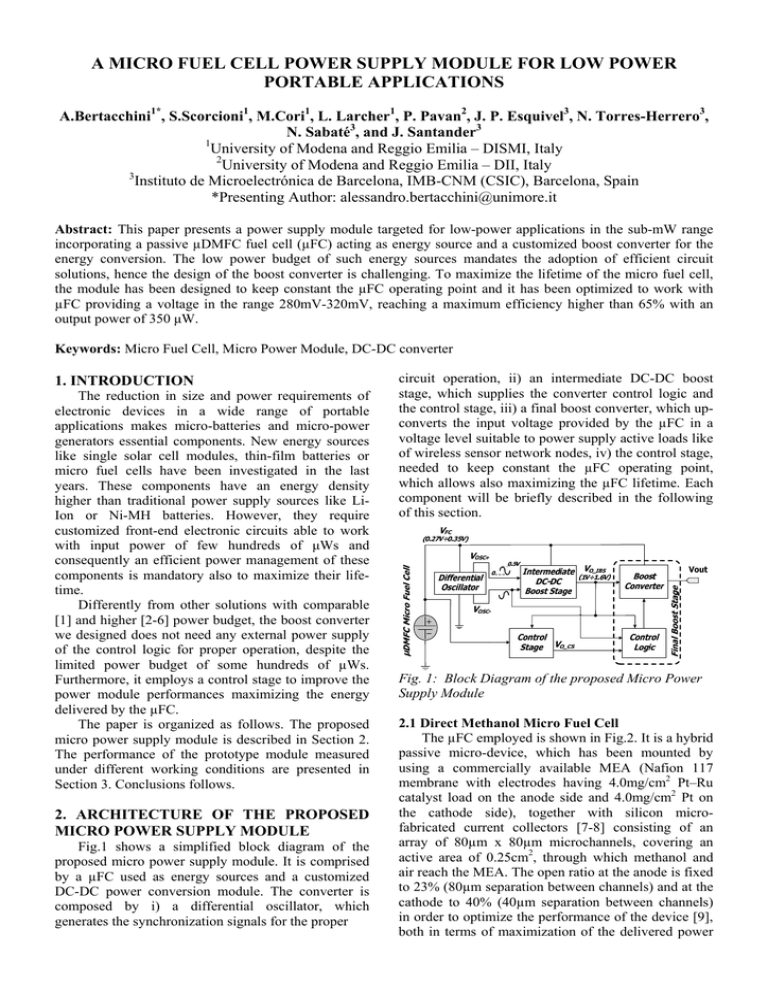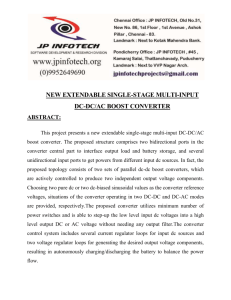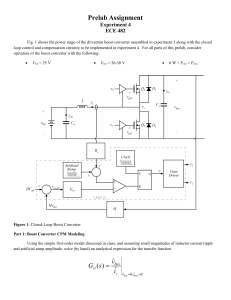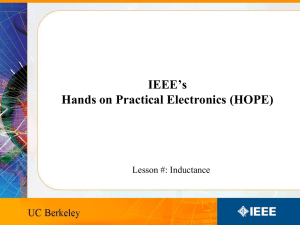A MICRO FUEL CELL POWER SUPPLY MODULE FOR LOW POWER
advertisement

A MICRO FUEL CELL POWER SUPPLY MODULE FOR LOW POWER PORTABLE APPLICATIONS A.Bertacchini1*, S.Scorcioni1, M.Cori1, L. Larcher1, P. Pavan2, J. P. Esquivel3, N. Torres-Herrero3, N. Sabaté3, and J. Santander3 1 University of Modena and Reggio Emilia – DISMI, Italy 2 University of Modena and Reggio Emilia – DII, Italy 3 Instituto de Microelectrónica de Barcelona, IMB-CNM (CSIC), Barcelona, Spain *Presenting Author: alessandro.bertacchini@unimore.it Abstract: This paper presents a power supply module targeted for low-power applications in the sub-mW range incorporating a passive µDMFC fuel cell (µFC) acting as energy source and a customized boost converter for the energy conversion. The low power budget of such energy sources mandates the adoption of efficient circuit solutions, hence the design of the boost converter is challenging. To maximize the lifetime of the micro fuel cell, the module has been designed to keep constant the µFC operating point and it has been optimized to work with µFC providing a voltage in the range 280mV-320mV, reaching a maximum efficiency higher than 65% with an output power of 350 μW. Keywords: Micro Fuel Cell, Micro Power Module, DC-DC converter 1. INTRODUCTION The reduction in size and power requirements of electronic devices in a wide range of portable applications makes micro-batteries and micro-power generators essential components. New energy sources like single solar cell modules, thin-film batteries or micro fuel cells have been investigated in the last years. These components have an energy density higher than traditional power supply sources like LiIon or Ni-MH batteries. However, they require customized front-end electronic circuits able to work with input power of few hundreds of μWs and consequently an efficient power management of these components is mandatory also to maximize their lifetime. Differently from other solutions with comparable [1] and higher [2-6] power budget, the boost converter we designed does not need any external power supply of the control logic for proper operation, despite the limited power budget of some hundreds of µWs. Furthermore, it employs a control stage to improve the power module performances maximizing the energy delivered by the µFC. The paper is organized as follows. The proposed micro power supply module is described in Section 2. The performance of the prototype module measured under different working conditions are presented in Section 3. Conclusions follows. 2. ARCHITECTURE OF THE PROPOSED MICRO POWER SUPPLY MODULE Fig.1 shows a simplified block diagram of the proposed micro power supply module. It is comprised by a µFC used as energy sources and a customized DC-DC power conversion module. The converter is composed by i) a differential oscillator, which generates the synchronization signals for the proper circuit operation, ii) an intermediate DC-DC boost stage, which supplies the converter control logic and the control stage, iii) a final boost converter, which upconverts the input voltage provided by the µFC in a voltage level suitable to power supply active loads like of wireless sensor network nodes, iv) the control stage, needed to keep constant the µFC operating point, which allows also maximizing the µFC lifetime. Each component will be briefly described in the following of this section. Fig. 1: Block Diagram of the proposed Micro Power Supply Module 2.1 Direct Methanol Micro Fuel Cell The µFC employed is shown in Fig.2. It is a hybrid passive micro-device, which has been mounted by using a commercially available MEA (Nafion 117 membrane with electrodes having 4.0mg/cm2 Pt–Ru catalyst load on the anode side and 4.0mg/cm2 Pt on the cathode side), together with silicon microfabricated current collectors [7-8] consisting of an array of 80µm x 80µm microchannels, covering an active area of 0.25cm2, through which methanol and air reach the MEA. The open ratio at the anode is fixed to 23% (80µm separation between channels) and at the cathode to 40% (40µm separation between channels) in order to optimize the performance of the device [9], both in terms of maximization of the delivered power density and in working stability. The VFC-JFC and PFC-JFC characteristics measured when the µFC is operated with 2M-methanol are shown in Fig.3. The power PFC peaks at a current density J≈34mA/cm2. Initial measurements shown in [8] confirmed that the total energy supplied by the µFC during its operative life, after fuel refilling and until fuel exhaustion, is maximized for a VFC corresponding to an operation point providing less current than that in the conditions of maximum power, in this device around 300mV. For this reason, the converter control stage has been designed to keep constant the µFC operating point in the defined range to account for cellto-cell variations, avoiding power bursts and maximizing its lifetime. Fig. 2: µDMFC Micro Fuel Cell used Fig. 3: Voltage vs. current density (VFC-JFC) and power density vs. current density (PFC-JFC) characteristics measured on the µDMFC micro fuel cell operated with 2M-methanol. 2.2 DC-DC Converter As mentioned previously, the converter is comprised by four main blocks. The first one is the oscillator which generates a voltage sinusoidal waveform at 170kHz with a roughly constant peak-to-peak amplitude VPP ≅ 0.5V. This signal is required for proper operation of the other blocks. The oscillator employs a differential LC topology with a cross-coupled pair of zero threshold voltage transistors to implement the negative resistance required for circuit oscillation. The choice of the oscillation frequency, comes from a compromise among opposite requirements. Increasing the switching frequency leads to higher efficiency in boost DC-DC converters, since this allows using smaller inductors with lower parasitic resistances, thus decreasing related power losses. However, higher frequencies lead to a higher power consumption of comparators required to control MOSFET switches. Of course, the efficiency optimization is crucial when handling micro sources. We selected the cross-coupled pair circuit topology for three main reasons: i) a differential approach allows reducing noise and disturbs of the intermediate DC-DC converters; ii) this topology allows directly biasing the MOSFET switches through the inductors of the LC oscillator; iii) this resonant oscillator topology allows generating output signals with a double amplitude compared to standard squaretype oscillators, thus guaranteeing the correct turn on and turn off the MOSFET switches in the intermediate DC-DC converter (IBS), which is the second main block of the system. As sketched in Fig. 1, the IBS is needed to quadruple the fuel cell input voltage, VFC (0.27V÷0.35V) into an intermediate voltage (1.0V÷1.6V) required to supply the control logic of the Final Boost Stage (FBS) and the operational amplifiers used in the Control Stage (CS). As shown in Fig. 4, the IBS is comprised of three building blocks: the Voltage Clamp (VC) and two cascaded classic DC-DC boost converters. The VC stage is a classical Dickinson’s charge pump realized to add to the control signals Vosc+ and Voscgenerated by the differential oscillator a DC-offset voltage equal to the threshold voltage of the MOSFET switches of the two IBS cascaded boost converters. Fig. 4: Schematic of the Intermediate DC-DC boost converter- IBS. For the IBS we proposed a two-stages solution in order to improve the efficiency and the stability of the circuit, [10]. Each boost converter stage doubles its input voltage, generating the total 4⋅VFC output voltage required to supply FBS and CS. Thus, their MOSFET switches are operated with duty cycle D=50%, while in a single stage solution MOSFET have to operate with D=75% to quadruple the input voltage VFC. This solution allows maximizing the circuit efficiency by reducing the power dissipation occurring at MOSFET turn-on and turn-off because of simultaneously non-zero ID and VDS. This power loss is thus directly related to the non-instantaneous MOSFET switching, which is in turn due to the fact that control signals are sinusoids (Vosc+ and Vosc-), instead of ideal square waves. Therefore, the MOSFET switching is faster with duty cycle D=50%, as in these conditions the switching occurs where the sinusoidal waveform has the steepest slope versus time, thus allowing minimizing switching time and related power losses. In other words, increasing/decreasing the duty cycle D rises the MOSFET switching time, thus increasing the power losses due to the simultaneous presence of non-zero ID and VDS. This finding is clearly demonstrated in Fig. 5, where MOSFET power losses of a classic single stage boost converter, simulated considering D=50% and D=75%, are compared. With D=75%, VCTRL.MOS (i.e. the gate-source voltage of the converter switching MOSFET) remains closer to the MOSFET threshold voltage for a longer time compared with D=50%, leading to a much higher power dissipation. Quantitatively, circuit simulations show that the proposed solution reduces the MOSFET power losses by ~40%, increasing the efficiency of the whole circuit by ~5%, despite the increase of the number of circuit components. Noticeably, this is extremely important when dealing with very low energy budget. a square waveform generated using a Pulse Width Modulation (PWM) technique. In this way the switching time is minimized as well as power dissipated by the MOSFETs at their turn-on and turnoff. The PWM control signal is generated by comparing the sinusoidal voltage provided by the differential oscillator to the constant control voltage generated by the control stage (CS), VO-CS. The Control stage CS is the last block of the converter. It is given by a standard analog control circuit required to keep constant the operating point of the µFC. The CS is a classic two-stage circuit comprised of an error amplifier with a cascaded gain stage to improve the circuit stability in steady state conditions. Since this stage is designed to keep constant the µFC operating point, the output voltage of the whole module depends on the load power requirements, and can be controlled by simple circuit solutions (for example, a limiter) not discussed in this paper. 3. EXPERIMENTAL RESULTS The realized prototype comprised by µFC and converter connected together is shown in Fig. 6. Fig. 6: Picture of the complete power supply module comprised of micro fuel cell and boost converter Fig. 5: Switching power losses on MOSFET driven by sinusoidal signal with duty cycle D=50% and D=75% The third main block of the DC-DC converter is the Final Boost Stage (FBS) which is a conventional boost converter and is the real DC-DC boost stage converting the power provided from the µFC. This block manages the most of the power, hence maximizing its efficiency is crucial to improve the efficiency of the whole converter. The inefficiencies of other building blocks lead to much smaller energy dissipation, thus penalizing less the whole circuit efficiency, as the power they handle is only a relatively small fraction of the total power available from the micro energy source. Noticeably, this is a key point in the design of the converter. As discussed previously, optimizing the efficiency requires that the FBS switching transistor is driven by In order to measure the performances of the circuit prototype, we arranged a dedicated experimental setup. We considered the efficiency as most important parameter to evaluate circuit performances. Fig.7 shows the efficiency of the whole converter measured varying the load current ILOAD. The inset shows the average efficiency of the boost converter plotted versus the µFC operating point. It is possible to note as the converter efficiency depends slightly on the load current ILOAD, and the maximum efficiency is obtained when the operating point of the µFC is kept constant to VFC=300mV. For these reasons the converter has been optimized to work for an input voltage VFC in the range 280mV320mV, thus accounting for µFC cell-to-cell variations and reaching a maximum efficiency higher than 65%. Fig.8 shows the power supplied by the µFC when operated at VFC=300mV along with the output voltage and output power of the power module. The power provided by the µFC and the output power of the boost converter remain roughly constant demonstrating the correct operation of the realized control stage, while the output voltage reduces with increasing ILOAD. Fig. 7: Boost converter efficiency plotted versus the load current ILOAD. The inset shows the average efficiency of the boost converter plotted versus the micro fuel cell operating point. Fig. 8: Power supplied by both the micro fuel cell and the whole power supply module are plotted versus the load current ILOAD along with the converter output voltage when VFC=300mV. 4. CONCLUSIONS In this paper we presented a power supply module targeted for sub-mW applications incorporating a passive µDMFC fuel cell acting as energy source and a customized boost converter for the energy conversion. The module has been designed to keep constant the µFC operating point under a wide range of working conditions, maximizing their lifetime and the energy delivered by the µFC itself. Differently from other solutions with comparable and higher power budget, the boost converter we designed does not need any external power supply despite the limited power budget of some hundreds of µWs. The prototype of the micro-power supply module we designed and realized is optimized to work for a VFC in the range 280mV-320mV and achieves interesting performances for low power applications (350 μW output power with an efficiency higher than 65%), being suitable for SiP solution with the μFC assembled together with the boost converter. REFERENCES [1] Carlson, E.; Strunz, K.; Otis, B.; 2009, “20mV Input Boost Converter for Thermoelectric Energy Harvesting”, VLSI Circuits, Symposium on, (16-18 June 2009) Page(s):162 - 163 [2] Kimball, J.W.; Flowers, T.L.; Chapman, P.L.; 2004, “Low-Input-Voltage, Low Power Boost Converter Design Issues”, Power Electronics Letters, IEEE, Volume 2, Issue 3, Sept. 2004 Page(s):96 – 99 [3] Damaschke, J.M.; 1997, “Design of a LowInput-Voltage Converter for Thermoelectric Generator”, Industry Applications, IEEE Transactions on Volume 33, Issue 5, Sept.-Oct. 1997 Page(s):1203 – 1207 [4] Richelli, A.; Colalongo, L.; Tonoli, S.; KovacsVajna, Z.M.; 2009, “ A 0.2-1.2 V DC/DC Boost Converter for Power Harvesting Applications”, Power Electronics, IEEE Transactions on Volume 24, Issue 6, June 2009 Page(s):1541 – 1546 [5] Ngok-Man Sze; Wing-Hung Ki; Chi-Ying Tsui; 2008, “Threshold Voltage Start-up Boost Converter for Sub-mA Applications”, Electronic Design, Test and Applications, 2008, DELTA 2008, 4th IEEE International Symposium on (2325 Jan 2008) Page(s):338 – 341 [6] Matsumoto, S.; Shodai, T.; Kanai, Y.; 2009, “A Novel Strategy of a Control IC for Boost Converter with Ultra Low Voltage Input and Maximum Power Point Tracking”, ISPSD Power Semiconductor Devices & IC's, 21st International Symposium on, (14-18 June 2009) Page(s):180 – 183 [7] Esquivel, J.P., Sabaté, N., Santander, J., Torres, N., Cané, C.; 2008, "Fabrication and characterization of a passive silicon-based direct methanol fuel cell", Microsystem Technologies, Volume 14, no. 4-5, 2008, p. 535-541 [8] N. Torres, J. Santander, J.P. Esquivel, N. Sabaté, E. Figueras, P. Ivanov, L. Fonseca, I. Gràcia and C. Cané; 2008, “Performance optimization of a passive silicon-based micro-direct methanol fuel cell”, Sensors & Actuators B, Volume 132, 2008 Page(s):540-544 [9] Esquivel, J. P.; Sabaté, N.; Santander, J.; TorresHerrero, N.; Gràcia, I.; Ivanov, P.; Fonseca, L.; Cané, C.; 2009, “Influence of current collectors design on the performance of a silicon-based passive micro direct methanol fuel cell”, Journal of Power Sources, Volume 194, 2009, Page(s): 391-396 [10] A. Bertacchini, S. Scorcioni, M. Cori, L. Larcher and P. Pavan, 2010, “250mV Input Boost Converter for Low Power Applications”, ISIE 2010, IEEE International Symposium on Industrial Electronics,(4-7 Jul 2010) Page(s): 533-538





